How to Figure Out Your Skin Type at Home in 5 minutes (Without a Dermatologist)
Ever spent money on a skincare product, only to end up with breakouts, dry patches, or that greasy feeling you can’t stand ? You’re not alone .We’ve all stood in front of shelves packed with moisturizers and face washes, thinking, “Is my skin dry? Oily? Or maybe both?”
And when the product you picked doesn’t work—or worse, makes your skin angry—it’s frustrating.
The truth is your skincare routine only works if it’s right for your skin type. If you’re not sure what your skin type is, don’t worry—this guide will help you figure it out from the comfort of home, no dermatologist visit required . Let’s break it down step by step so you can finally give your skin what it really needs.
Why Your Skin Type Matters
Using the wrong products can:
✔ Worsen dryness or oiliness
✔ Trigger breakouts or irritation
✔ Waste money on products that don’t work
But when you know your skin type, you can:
✔ Choose the right cleansers, moisturizers, and treatments
✔ Prevent common skin issues
✔ Build a simple, effective routine
The 5 Main Skin Types Explained (Oily, Dry, Normal, Sensitive, Combination)
1. Oily Skin Type:
💧What Causes Oily Skin & What It Means for You
Oily skin is one of the most common skin types—and it all starts with your skin producing more oil than it actually needs. Here’s a breakdown of what’s going on:
- It all comes down to oil production:
Your skin has tiny oil glands (called sebaceous glands), and when they go into overdrive, they release too much oil—or sebum . - Why it happens:
According to dermatologists , several things can lead to excess oil, including:- Stress
- Hot or humid weather
- Hormonal changes (like puberty or periods)
- Family history (yep, it can be genetic!)
- How it shows up on your skin:
- A shiny or greasy look—especially in your T-zone (forehead, nose, and chin)
- Skin that feels slick, even shortly after washing
- Clogged pores that lead to blackheads or acne
- Noticeably larger pores
- But it’s not all bad news:
While oily skin can be frustrating but people with oilier skin may develop fewer fine lines and wrinkles over time. The natural oils help keep the skin plump and protected longer.
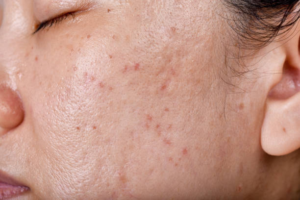
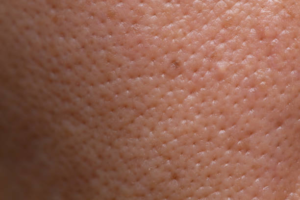
-
Dry Skin Type:
🌬️ What You Should Know About Dry Skin
Dry skin happens when your skin doesn’t make enough natural oil (called sebum), which is important for keeping it soft, smooth, and protected. Here’s how it affects your skin and what might be causing it:
- Lack of oil is a sign of lack of moisture: without enough sebum, your skin can’t lock in hydration properly . This often leads to water escaping from the surface, making your skin feel dry and uncomfortable.
- Common signs of dry skin:
- A tight or stretched feeling, especially after cleansing
- Rough patches or flaky areas
- Dull, uneven texture
- Fine lines that seem more visible
- Itchiness or occasional irritation
- Why it happens:
According to dermatologists, one of the main culprits is a weakened skin barrier. When this protective layer is damaged, moisture escapes more easily—and your skin can start to feel dry, tight, or even sore. - Everyday habits that can make it worse :
- Using harsh or drying skincare products (like strong soaps or alcohol-based toners)
- Taking long, hot showers (they strip natural oils away)
- Skipping moisturizer or using one that isn’t rich enough for your skin’s needs
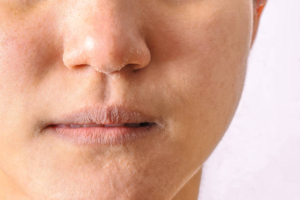
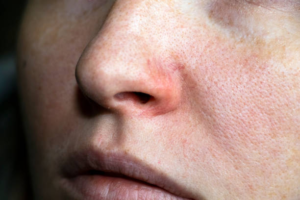
-
Normal Skin Type
🌿 What Is Normal Skin, Really?
If your skin usually feels soft, balanced, and just…fine—you might have what’s called normal skin.
As dermatologists put it, “Normal skin means your face feels comfortable—not too oily, not too dry.” It’s that sweet spot where your skin isn’t acting up with greasy spots, dry flakes, or random breakouts.
Normal skin feels pretty even all over. It looks healthy, feels smooth, and usually isn’t sensitive to most products.
Here are a few signs you might have normal skin:
- Your skin feels hydrated but never greasy
- You rarely deal with breakouts, redness, or irritation
- Your pores are small and not very noticeable
- Your face feels calm, not tight or shiny
If that sounds like you, consider yourself lucky! Normal skin is low-maintenance—but that doesn’t mean you should skip skincare. It still needs gentle cleansing, sun protection, and daily moisture to stay in balance.
-
Combination Skin Type:
🌗 What Is Combination Skin?
Do parts of your face feel oily while other areas feel dry or tight? That’s a classic sign of combination skin.
According to dermatologists, combination skin usually means you have an oily T-zone—your forehead, nose, and chin—while your cheeks are drier or more sensitive. But it doesn’t look the same for everyone.
For some, it might mean a shiny nose and dry patches around the mouth. For others ,it could show up as an oily forehead and slightly flaky cheeks. Some people even notice redness or dull, ashy tones in the drier areas—especially depending on their skin tone.
And here’s the tricky part: combination skin isn’t always consistent.
It can change with the seasons, your stress levels, your period, or even a new skincare product.
So if your face feels like a mix of different skin types, don’t worry—it’s completely normal. The key is learning how to balance both zones without over-drying or over-moisturizing.
-
Sensitive Skin Type:
🌸 What Is Sensitive Skin & Why Does It React So Easily?
Does your skin ever feel like it’s overreacting—getting red, itchy, or stinging even with the mildest product? That could be a sign of sensitive skin.
Unlike other skin types, sensitive skin isn’t about how oily or dry you are. It’s more about how easily your skin reacts to things—whether that’s an ingredient in your moisturizer or something in the air like pollution or dust.
Here’s how sensitive skin usually behaves:
- It may sting, burn, or itch after applying certain skincare products
- You might notice redness or irritation more often than others
- Your skin might freak out from things like fragrance, alcohol, or even weather changes
And guess what? Any skin type—oily, dry, or combination—can also be sensitive. It’s not a one-size-fits-all category.
Experts still aren’t 100% sure why some people have more sensitive skin than others, but a weak or damaged skin barrier could be the reason. When that outer layer isn’t doing its job, irritants can sneak in and cause trouble.
If your skin is sensitive, the best approach is to keep it calm and simple. Use gentle, fragrance-free products and focus on strengthening your skin barrier.
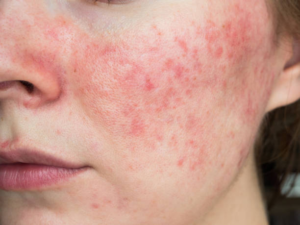
How to Tell What Skin Type You Have — At Home?
Below are two super easy methods you can try today to get a better idea of whether your skin is oily, dry, normal, combination, or sensitive.
Let’s get started — your perfect skincare match is waiting!
- 🪞The “Watch and Wait” (Bare-Faced) Method
This one’s super easy—and all you need is your clean, bare face.
How to do it:
- Start by washing your face with a gentle cleanser.
- Pat it dry with a soft towel—nothing harsh!
- Then, don’t apply anything—no moisturizer, toner, or serum.
- Wait for 30 minutes, then check yourself out in the mirror.
What to look for:
- Shiny all over? You probably have oily skin.
- Tight, flaky, or rough? That’s a sign of dry skin.
- Shiny just in the T-zone (forehead, nose, chin)? Likely combination skin.
- Balanced, not dry or oily? Lucky you—that’s normal skin.
This method is perfect if you want to see how your skin naturally behaves without any products interfering.
-
🧻 The Blotting Sheet Trick
If you’ve got blotting papers at home (or even tissue paper in a pinch), this quick test can help confirm your skin type.
Here’s how it works:
- Clean your face, dry it gently, and wait 30 minutes—just like the first method.
- Then, press a blotting paper onto different areas of your face: forehead, nose, cheeks, and chin.
- Hold the paper up to the light to see how much oil it soaked up.
What the results mean:
- Lots of oil on all areas? Your skin is probably oily.
- Little to no oil? You likely have dry skin.
- Oil only on the T-zone? That’s combination skin.
- Just a bit of oil from every area? You’ve got normal skin.
Both of these methods are super simple and take just a half hour. Once you know your skin type, you can start choosing the right products that actually work for your skin—not someone else’s.
Remember: your skin is unique, and there’s no “perfect” type—just the right care for your face.
Now that you know how to identify your skin type at home, why not take the next step? Start building a skincare routine that actually works with your skin—not against it.
💬 Have you tried one of these methods before? Let me know your skin type in the comments below!